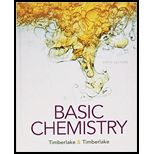
Concept explainers
Interpretation:
The amount of energy required to vaporize 15.8 g N2 at its boiling point needs to be calculated.
Concept Introduction:
The latent heat of vaporization is defined as the amount of heat required to vaporize 1 g of the substance. The unit is in J/g. For nitrogen gas, the heat of vaporization at its boiling point is 198 J/g.
Thus, the amount of heat required to vaporize 1 g of the nitrogen gas is 198 J.
It is mathematically represented as follows:
Here, m is mass of nitrogen gas and L is latent heat of vaporization.
Answer to Problem 10.53FU
Explanation of Solution
The mass of the nitrogen gas is 15.8 g.
The amount of heat required to vaporize 1 g of the nitrogen gas is 198 J. This is the latent heat of vaporization.
Thus, at the boiling point, the heat required to vaporize 15.8 g of the nitrogen gas can be calculated as follows:
Putting the values,
Therefore, the amount of heat required is
Therefore, the amount of heat required is
Want to see more full solutions like this?
Chapter 10 Solutions
Basic Chemistry - With Access
 ChemistryChemistryISBN:9781305957404Author:Steven S. Zumdahl, Susan A. Zumdahl, Donald J. DeCostePublisher:Cengage Learning
ChemistryChemistryISBN:9781305957404Author:Steven S. Zumdahl, Susan A. Zumdahl, Donald J. DeCostePublisher:Cengage Learning ChemistryChemistryISBN:9781259911156Author:Raymond Chang Dr., Jason Overby ProfessorPublisher:McGraw-Hill Education
ChemistryChemistryISBN:9781259911156Author:Raymond Chang Dr., Jason Overby ProfessorPublisher:McGraw-Hill Education Principles of Instrumental AnalysisChemistryISBN:9781305577213Author:Douglas A. Skoog, F. James Holler, Stanley R. CrouchPublisher:Cengage Learning
Principles of Instrumental AnalysisChemistryISBN:9781305577213Author:Douglas A. Skoog, F. James Holler, Stanley R. CrouchPublisher:Cengage Learning Organic ChemistryChemistryISBN:9780078021558Author:Janice Gorzynski Smith Dr.Publisher:McGraw-Hill Education
Organic ChemistryChemistryISBN:9780078021558Author:Janice Gorzynski Smith Dr.Publisher:McGraw-Hill Education Chemistry: Principles and ReactionsChemistryISBN:9781305079373Author:William L. Masterton, Cecile N. HurleyPublisher:Cengage Learning
Chemistry: Principles and ReactionsChemistryISBN:9781305079373Author:William L. Masterton, Cecile N. HurleyPublisher:Cengage Learning Elementary Principles of Chemical Processes, Bind...ChemistryISBN:9781118431221Author:Richard M. Felder, Ronald W. Rousseau, Lisa G. BullardPublisher:WILEY
Elementary Principles of Chemical Processes, Bind...ChemistryISBN:9781118431221Author:Richard M. Felder, Ronald W. Rousseau, Lisa G. BullardPublisher:WILEY





